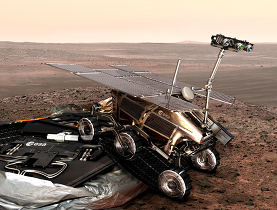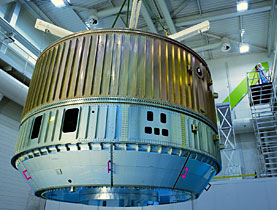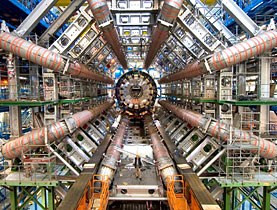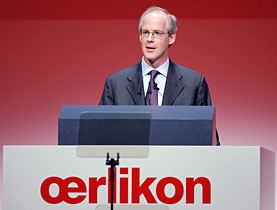Testing for Europe’s next Mars rover underway

Sometime in early 2015, two parachutes and a glorified airbag will lead the ExoMars Rover, an autonomous robotic vehicle, toward a dusty and hostile Martian terrain.
After millions of kilometres and over a year in space, engineers in Switzerland and across Europe will be keeping their fingers crossed that all goes according to plan as the small craft lands on the Red Planet.
But what happens next with the six-wheel, 250-kilogram machine will be the important part.
It will also be the culmination of over a decade of research, development and testing by firms tied to the 17-member European Space Agency (ESA).
Oerlikon Space, one of the country’s leading technology firms, has been charged with developing the locomotion system for the 1.5-meter-long rover. It promises to be the first of its kind to be able to navigate the surface of the Red Planet as well as drill for and evaluate samples.
Zurich-based Oerlikon completed a full-scale preliminary test model of the rover in mid-April and is currently conducting a month-long series of tests to make sure the vehicle will actually be able to move around. Things are looking good, it says.
“We are optimistic that we shall soon be able to conclude these [tests] successfully,” said Axel Deich, Oerlikon’s chief executive.
Expensive re-try
The €1 billion (SFr1.63 billion) ExoMars project is a second attempt at finding life on Mars for the ESA.
In 2003, space enthusiasts were massively disappointed when this rover’s British-made predecessor, Beagle 2, failed to communicate with its Earth-bound masters.
That mission was an expensive failure, an embarrassment for Europe’s space authorities and resulted in a British commission of enquiry.
ExoMars, to which the Swiss government is contributing around SFr30 million, will be the first part of the ESA’s Aurora exploration programme.
Oerlikon engineers have been working on the project for the past four years and say they have budgeted 20 full-time specialists for the next three years. There is little appetite for failure.
“One error means the end of the mission,” Stephane Michaud, a systems engineer in the project, told swissinfo. On Mars, “nobody will repair the rover.”
Technical side
The craft’s chassis will contain 18 state-of-the-art electric motors and 21 sensors, allowing it to traverse rocky territory at a not-so-blistering 100 metres per hour, engineers say.
They add that a more realistic pace for the solar-powered craft – which operates on only the energy equivalent to three conventional light bulbs – will be closer to 100 meters per day.
Apart from tests using realistic computer modelling, Oerlikon engineers have taken to the sandbox.
A 20-square-metre pad containing specially developed ultra fine sand has allowed the designers to evaluate how well the rover can manoeuvre on a Mars-like surface. One of the distinguishing features of the ExoMars Rover, apart from its unique onboard drilling and materials analysis capabilities, will be the way it gets around.
Regular rubber tyres don’t work on Mars, which experiences high levels of destructive radiation and temperatures ranging from minus 140 to 120 degrees Celsius.
Instead, the rover will ride on specially treated titanium wheels, says the head of Oerlikon’s mechanisms and instruments division, Didier Manzoni.
“You have very thin structures,” he told swissinfo. “And when you have very thin structures, you want to avoid having micro-cracks that may develop.”
Manzoni says the company has developed its own metallurgical processes and coatings to ensure that the critical parts of the locomotive mechanism perform well during the 180-day operation on the harsh Martian terrain.
Michaud, who trained at the renowned Federal Institute of Technology in Lausanne, is excited about his first space project. He has been with Oerlikon for the past four years.
Intense competition
Manzoni says that competition for talent between the world’s top space firms is intense. It isn’t a big business, and for the most part, it is collegial.
“The spirit is quite good,” he said, adding that in the non-commercial sector, institutions rely on one another – to a certain point.
“On one side, you need the lessons learned from the American rovers and you need also the images of the soil for doing the simulations.”
“But on the other side, it’s clear that if you’re focusing too much on an existing design, then you are never innovative. At concept level, you must free your head.”
swissinfo, Justin Häne in Oerlikon
The ExoMars mission is scheduled to start in 2013, when a French-built Ariane 5 rocket will blast off from the Guiana Space Centre in the Atlantic Ocean.
After a journey of 9-10 months, the craft’s orbiter will descend toward Mars, where it will circle the planet until suitable weather conditions.
Once on the surface, the self-navigating rover will search for life using a 2-metre drill.
The instruments contained within the vehicle will evaluate the planet’s geochemestry and water distribution.
It will also identify hazards to future missions.
The rover’s mission will last for 180 days.
The landing module is to report information about the planet’s conditions for at least six years.
Oerlikon Space is a division of Oerlikon, which employs more than 19,000 employees at 170 sites in 35 countries.
The space division includes some 300 people in Zurich.
Known as Unaxis until its 2005 takeover and Oerlikon-Bührle before that, it is a stalwart of the Swiss manufacturing sector.
Apart from its space business, the company is active in solar technology, thin film coating, vacuum systems, textile machines, drive systems and precision components.
In 2007, the company posted a profit of SFr319 million ($320 million) on sales of SFr5.63 billion.

In compliance with the JTI standards
More: SWI swissinfo.ch certified by the Journalism Trust Initiative



You can find an overview of ongoing debates with our journalists here. Please join us!
If you want to start a conversation about a topic raised in this article or want to report factual errors, email us at english@swissinfo.ch.